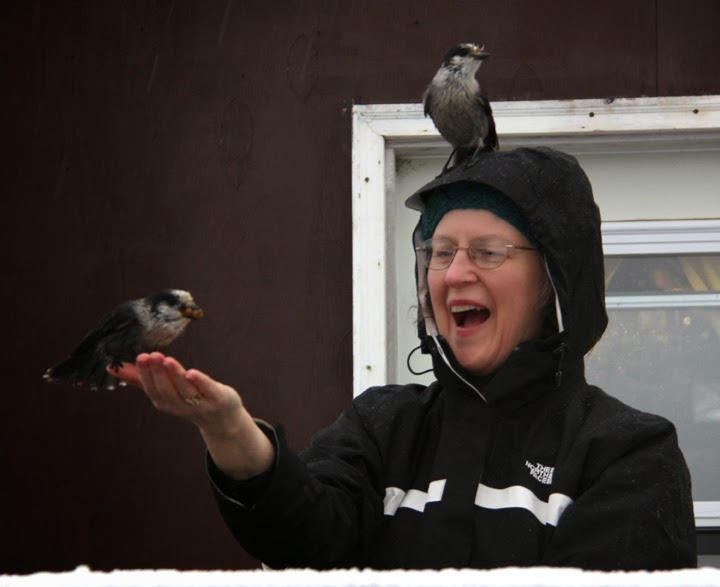Our bird-banding morning on November 16, 2014 at Seven Islands State Birding Park was chilly but rewarding!
Sometimes its a little hard to get out of bed way before dawn, especially when you're anticipating at least four hours of being out in the cold, but seeing the wintering bird population at Seven Islands State Birding Park makes it well worth the effort.
During the winter months we have the great pleasure of hosting wintering sparrows in the grassland and shrubby habitat of the park.
Sparrows like to hang out on the stems of dead flowers and grasses eating seeds or foraging on the ground underneath. Often referred to as "little-brown-jobs", they are not really brown and dull as suggested, but display a bright array of neutral colors--brown, tan, rust, gray, cream, black and white--arranged in intricate contrasting patterns. The nickname, of course, also refers to the fact that that they aren't the easiest of birds to see. You may only catch a flash of brown as a shy sparrow disappears into the nearest thicket!
The Swamp Sparrow above was still growing in new feathers, shown as white around his face, but when the fresh plumage grows in fully, he will look more like the sparrow below with a mostly gray face, dark crown and rust-colored wings. Swamp Sparrows breed in the boreal forests of Canada and the northeastern United States and prefer brushy habitat that is either wet or near water.
I was introduced to Swamp Sparrows at Seven Islands in 2009, along with the Savannah Sparrow, Grasshopper Sparrow, Fox Sparrow, White-crowned Sparrow and Field Sparrow--all at the banding table.
Above, Billie Cantwell, banding apprentice, and Mark Armstrong, Master Bander, discuss plumage characteristics that help to determine the age of this Swamp Sparrow.
While walking up and down hills and removing birds from nets, banding team members stay warm. While waiting for the next net-run, it gets chilly and it's time to bundle up. In the image above, Patty Ford is showing Eddy Whitson the photo she took of the Swamp Sparrow.
Above, Mark Armstrong, examines an Eastern Towhee with team member, Eddy Whitson, looking on.
Eastern Towhees, large, colorful sparrow-like birds, remain in Tennessee year around and are often found in our backyards.
Above, Mark Armstrong (left), Janie Kading and Billie Cantwell (right) at the banding table.
Above, a Field Sparrow with its new band just before release. Field Sparrows both breed and winter in Tennessee. The banding program at Seven Islands is giving biologists valuable information about the area's birds, the impact of changing land management practices on the bird population, and information about the health and site fidelity of the bird species.

Above and below, banding team members remove birds captured in a net.
Some net-runs, such as this one, may hold a large number of birds. The birds are held in soft cloth bags until they are processed and released.
Below, Janie Kading helps Dawn Johnson separate the bags and safely hang them on the carousel.
When the weather is cold as it was this day, in the mid 30's F, the banders band the bird, determine its age and release it without taking the time to measure the wings and tail or weigh the bird. This allows the bird to get back to its activities more quickly. Measurements help document the bird's health and general characteristics for referrence when recaptured.
Above, a striking juvenile White-crowned Sparrow, and below, an adult White-crowned Sparrow.
The White-crowned Sparrow breeds in northern Canada and the western United States and starts to arrive to winter in Tennessee around October. These sparrows are most often found on the ground kicking up leaf litter with double-footed scratching.
Above and below, a Savannah Sparrow--a sparrow of open grasslands.
A Field Sparrow showing its peach-colored beak, white eye-ring and rusty plumage. Below, you see the intricate color patterns in its back and wing plumage.
See what I mean about beauty?
Visit my previous posts on
bird banding.
Knoxville Chapter, Tennessee Ornithological Society
Visit the Knoxville Chapter of TOS on
Facebook
Seven Islands State Birding Park







































